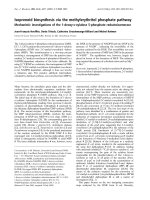Abdominal Trauma - Investigations
Bạn đang xem bản rút gọn của tài liệu. Xem và tải ngay bản đầy đủ của tài liệu tại đây (384.26 KB, 37 trang )
ABDOMINAL TRAUMA:
INVESTIGATIONS
What are the two major types of abdominal trauma?
The two types of injury are blunt and penetrating. The
abdomen may be considered as being composed of five parts:
᭹
Abdominal wall: front and back
᭹
Subcostal portion: containing the stomach, liver, spleen and
lesser sac
᭹
Pelvic portion: containing the rectum, internal genitalia and
iliac vessels
᭹
Intraperitoneal portion in between the above: containing
the small and large bowel
᭹
Retroperitoneum: containing the kidneys, urinary tract,
great vessels, pancreas and the rest of the colon
Which abdominal organs are most commonly
injured?
The three most commonly injured organs are the liver, spleen
and kidneys.
How may suspected injuries be investigated?
The initial investigations performed to assess the abdomen as
a whole are
᭹
Plain radiography: also assesses the bony pelvis
᭹
Ultrasound: particularly good for the presence of free
f luid in the abdomen, or haematoma around solid organs.
There is a 10% risk of missing a signif icant injury
᭹
Diagnostic peritoneal lavage (DPL): this is 98% sensitive
for intra-peritoneal bleeding
᭹
CT scanning: this can be used if the results of the DPL are
equivocal, and may also be performed at the same time as
a brain scan. Very good for retroperitoneal injury, less so
for hollow viscus injury such as the bowel
SURGICAL CRITICAL CARE VIVAS
A
ABDOMINAL TRAUMA: INVESTIGATIONS
᭢
1
A
ABDOMINAL TRAUMA: INVESTIGATIONS
Under which circumstances would you perform a
diagnostic peritoneal lavage (DPL)?
Some of the indications are
᭹
A suspicion of abdominal trauma on clinical examination
᭹
Unexplained hypotension: with the abdomen being the
source of occult haemorrhage
᭹
Equivocal abdominal examination because of head injury
and reduced level of consciousness
᭹
The presence of a wound that has traversed the
abdominal wall, but there is no indication for immediate
laparotomy, e.g. a stab wound in a stable patient
When is DPL contraindicated?
The most important contraindication for DPL is in the
situation which calls for mandatory laparotomy, e.g. frank
peritonitis following trauma, abdominal gunshot injury or a
hypotensive patient with abdominal distension.
How is DPL most commonly performed?
Performance of a DPL by the open method
᭹
Requires an aseptic technique
᭹
The abdomen is decompressed by insertion of a urinary
catheter and nasogastric tube
᭹
Local anaesthetic is administered to the subumbilical area
in the mid-line
᭹
An incision is made over this point. If a pelvic fracture is
suspected, then a supraumbilical incision is made to
prevent haematoma disruption
᭹
Dissection is performed down to the peritoneum and the
cannula is inserted under direct vision, guiding it towards
the pelvis
᭹
One litre of warmed saline is infused. Tilting and gently
rolling the patient helps distribution
᭹
The bag of saline can be left on the f loor to siphon off
the sample f luid from the abdomen
SURGICAL CRITICAL CARE VIVAS
᭢
2
What are the positive criteria with DPL?
᭹
Lavage f luid appears in the chest drain or urinary catheter
᭹
Frank blood on entering the abdomen
᭹
Presence of bile or faeces
᭹
Red cell count of Ͼ100,000/l
᭹
White cell count of Ͼ500/l
᭹
Amylase of Ͼ175 U/ml
SURGICAL CRITICAL CARE VIVAS
A
ABDOMINAL TRAUMA: INVESTIGATIONS
3
A
ACCESSING THE THORAX
ACCESSING THE THORAX
In which major ways may the thorax be accessed?
᭹
Percutaneous methods
Needle thoracostomy: to drain f luid, air or for biopsy of
tissue
Tube thoracostomy (‘chest drain’): for drainage of air or
f luid
Thoracoscopic surgery: permits procedures such as
lung/pleural biopsy, lobectomy, pleurodesis,
pleurectomy, sympathectomy, pericardiocentesis and
pericardial window
᭹
Thoracotomy
Median sternotomy: from the top of the manubrium at
the jugular notch, passing longitudinally through the
sternum to the xiphisternum. It permits access to the
pericardium, great vessels, and both hemithoraces
Posterolateral thoracotomy: the most common
approach in thoracic surgery. The incision runs from a
point mid-way between the medial scapular edge and
the thoracic spine, following a curve that runs 2 cm
below the inferior scapular angle, to the mid-point of
the axilla
Anterior thoracotomy: from the sternal edge, curving
laterally along the intercostal space below the nipple to
the axilla. It allows lung, pericardial and lung access, and
also to lymph nodes in the aorto-pulmonary window
Posterior thoracotomy: the line of the incision is
similar to that of a posterolateral thoracotomy, but starts
at a more posterior point, encroaching on to the
trapezius and erector spinae muscles. It allows access to
the lung and great vessels for some paediatric cardiac
procedures
Bilateral anterior sternotomy (‘clamshell’ incision):
this incision runs from below one nipple to the
contralateral side, dividing the body of the sternum
in-between. It permits emergency access to the
SURGICAL CRITICAL CARE VIVAS
᭢
4
pericardium and simultaneous exposure of both pleural
cavities
Thoraco-laparotomy: the incision runs like that of a
posterolateral thoracotomy, but continues anteriorly to
cross the costal margin at the junction of the sixth and
seventh ribs. The line runs for another 5 cm into the
abdominal wall. It is extended inferiorly as a para-
median or mid-line laparotomy. It permits access to
posterior mediastinal structures, such as the aorta or
oesophagus as they run into the abdomen
᭹
Mediastinoscopy: the incision runs across the anterior
neck, two f ingers-breadth above the jugular notch. Allows
access to the sub-carinal lymph nodes for disease diagnosis
and staging
Which important piece of anaesthetic equipment is
required for thoracotomy, and why?
The double-lumen endobronchial tube. This permits the use
of one-lung anaesthesia where one lung may be collapsed and
inf lated at will for the purposes of surgery. This is particularly
important for thoracoscopy where one lung has to be col-
lapsed to permit the safe passage of the instruments through
the thoracic wall.
What is the important pre-requisite to closure of all
thoracotomies?
Chest drain insertion. Post cardiac surgery, one or two drains
may be inserted into the mediastinum/posterior peri-
cardium, exiting through the skin subcostally. Other drains
are placed into any opened pleural space, e.g. during internal
mammary artery harvest. After thoracotomy, one apical and
one basal chest drain may be placed, both exiting sub-costally.
Briefly mention some important local complications
of thoracotomy.
Wound complications
᭹
Early:
Immediate dehiscence from poor technique
SURGICAL CRITICAL CARE VIVAS
A
ACCESSING THE THORAX
᭢
5
A
ACCESSING THE THORAX
Haematoma formation
Poor pain control leading to atelectasis, retention of
secretions, hypoxia and infection
᭹
Intermediate:
Infection, leading to wound dehiscence
᭹
Late:
Post-thoracotomy neuralgia
Pulmonary complications
᭹
Early:
Air leak: seen as continuous bubbling from the drains
when placed on suction. May be due to parenchymal
injury or a leak from the suture-line of a bronchial
stump
Bleeding: producing haemothorax. May be from the
raw parenchymal surface, or from a larger vessel
᭹
Intermediate:
Pneumonia: can lead to a lung abscess
Pulmonary oedema: seen particularly in the contralateral
lung following pneumonectomy. May also occur
following re-expansion of a chronically collapsed or
compressed lung from effusion
᭹
Late:
Chronic broncho-pleural fistula
Empyema
SURGICAL CRITICAL CARE VIVAS
6
ACID-BASE
Define the pH.
The pH is Ϫlog
10
[H
ϩ
].
What is the pH of blood?
7.36–7.44.
Where does the acid load (H
؉
) in the body come
from?
Most of the H
ϩ
in the body comes from CO
2
generated from
metabolism. This enters solution, forming carbonic acid
through a reaction mediated by the enzyme carbonic anhy-
drase.
Acid is also generated by
᭹
Metabolism of the sulphur-containing amino acids
cysteine and methionine
᭹
Anaerobic metabolism, generating lactic acid
᭹
Generation of the ketone bodies acetone, acetoacetate and
-hydroxybutyrate
What are the main buffer systems in the intravascular,
interstitial and intracellular compartments?
In the plasma the main systems are
᭹
The bicarbonate system
᭹
The phosphate system
᭹
Plasma proteins
᭹
Globin component of haemoglobin
Interstitial: the bicarbonate system
Intracellular: cytoplasmic proteins
What does the Henderson–Hasselbalch equation
describe, and how is it derived?
This equation, which may be applied to any buffer system,
defines the relationship between dissociated and undissociated
2+
424
(HPO + H H PO )
ϪϪ
22 23 3
CO HO HCO H HCO
+−
++
SURGICAL CRITICAL CARE VIVAS
A
ACID-BASE
᭢
7
A
ACID-BASE
acids and bases. It is used mainly to describe the equilibrium
of the bicarbonate system.
The dissociation constant,
Therefore
Taking the log
Taking the negative log, which expresses the pH, and where
Ϫlog K is the pK
Invert the term to remove the minus sign
The [H
2
CO
3
] may be expressed as pCO
2
ϫ 0.23, where 0.23
is the solubility coefficient of CO
2
(when the pCO
2
is in kPa).
The pK is equal to 6.1.
Thus,
Which organ systems are involved in regulating
acid-base balance?
The main organ systems involved in regulating acid-base
balance are
3
2
[HCO ]
pH 6.1 log .
pCO 0.23
−
=+
×
3
23
[HCO ]
pH pK log
[H CO ]
−
=+
23
3
[H CO ]
pH pK log
[HCO ]
−
=−
23
3
[H CO ]
log[H ] log K log
[HCO ]
+
−
=+
23
3
[H CO ]
[H ] K
[HCO ]
+
−
=
3
23
[H ][HCO ]
K
[H CO ]
+−
=
22 23 3
CO HO HCO H HCO
+−
++
SURGICAL CRITICAL CARE VIVAS
᭢
8
᭹
Respiratory system: this controls the pCO
2
through
alterations in alveolar ventilation. Carbon dioxide
indirectly stimulates central chemoceptors (found in the
ventro-lateral surface of the medulla oblongata) through
H
ϩ
released when it crosses the blood-brain barrier
(BBB) and dissolves in the cerebrospinal f luid (CSF)
᭹
Kidney: this controls the [HCO
3
Ϫ
], and is important for
long term control and compensation of acid-base
disturbances
᭹
Blood: through buffering by plasma proteins and
haemoglobin
᭹
Bone: H
ϩ
may exchange with cations from bone mineral.
There is also carbonate in bone that can be used to
support plasma HCO
3
Ϫ
levels
᭹
Liver: this may generate HCO
3
Ϫ
and NH
4
ϩ
(ammonia)
by glutamine metabolism. In the kidney tubules, ammonia
excretion generates more bicarbonate
How does the kidney absorb bicarbonate?
There are three main methods by which the kidneys increase
the plasma bicarbonate
᭹
Replacement of filtered bicarbonate with bicarbonate
that is generated in the tubular cells
᭹
Replacement of filtered phosphate with bicarbonate that
is generated in the tubular cells
᭹
By generation of ‘new’ bicarbonate from glutamine that is
absorbed by the tubular cell
Define the base deficit.
The base deficit is the amount of acid or alkali required to
restore 1 l of blood to a normal pH at a pCO
2
of 5.3 kPa and
at 37°C. It is an indicator of the metabolic component to an
acid-base disturbance. The normal range is Ϫ2 to ϩ2 mmol/l.
SURGICAL CRITICAL CARE VIVAS
A
ACID-BASE
9
A
ACUTE RENAL FAILURE
ACUTE RENAL FAILURE
What is the definition of acute renal failure?
This is the inability of the kidney to excrete the nitrogenous
and other waste products of metabolism and can develop over
the course of a few hours or days. It is therefore a biochem-
ical diagnosis
How are the causes basically classified?
The causes may be considered to be pre-renal, renal or post-
renal.
What are the major ‘renal’ causes of acute renal
failure?
᭹
Acute tubular necrosis
᭹
Glomerulonephritis
᭹
Interstitial nephritis
᭹
Bilateral cortical necrosis
᭹
Reno-vascular: vasculitis, renal artery thrombosis
᭹
Hepatorenal syndrome
What is acute tubular necrosis?
Acute tubular necrosis is renal failure resulting from injury to
the tubular epithelial cells, and is the most important cause of
acute renal failure. There are two types
᭹
Ischaemic injury: following any cause of shock with
resulting fall in the renal perfusion pressure and
oxygenation
᭹
Nephrotoxic injury: from drugs (aminoglycosides,
paracetamol), toxins (heavy metals, organic solvents), or
myoglobin (from rhabdomyolysis)
SURGICAL CRITICAL CARE VIVAS
᭢
10
What are the major ‘post-renal’ causes?
᭹
Acute obstruction from calculi
᭹
Obstruction from tumours arising from the renal
parenchyma or transitional epithelium of the
pelvi-calyceal system
᭹
Extrinsic compression from pelvic tumours
᭹
Iatrogenic injury, e.g. inadvertent damage to the ureters
during bowel surgery
᭹
Prostatic obstruction
᭹
Increased intra-abdominal pressure (>30 cmH
2
O)
Which part of the kidney is the most poorly perfused?
The renal medulla is more poorly perfused than the cortex.
This ensures that the medullary interstitial concentration
gradient formed by tubular counter current multiplication is
preserved and maintained.
Which part of the nephron is the most susceptible to
ischaemic injury, and why?
The cells of the thick ascending limb are the most susceptible
to ischaemic injury for two important reasons
᭹
The cells reside in the medulla, which has poorer
oxygenation than the cortex
᭹
The active Na
ϩ
-K
ϩ
ATPase pumps at the cell membrane
have a high oxygen demand
What are the basic steps in the pathogenesis of acute
renal failure?
The basic steps in the pathogenesis are
᭹
Initially, there is renal parenchymal ischaemia: as part of
the compensatory response to a fall in the renal perfusion
pressure, there is vasoconstriction of the efferent arteriole.
Thus, by reducing the pre to post capillary resistance ratio,
the capillary filtration pressure is preserved at the expense
of reducing the blood supply to the tubules from the
efferent arteriole and vasa recta. This leads to worsening
cortical and medullary ischaemia
SURGICAL CRITICAL CARE VIVAS
A
ACUTE RENAL FAILURE
᭢
11
A
ACUTE RENAL FAILURE
᭹
Tubular cell ischaemia and necrosis leads to cells being
shed into the tubular lumen, causing obstruction
᭹
This promotes a ‘back-leak’ of tubular f luid into the
interstitium, increasing the interstitial hydrostatic pressure
᭹
This reduces tubular f luid reabsorption and worsens
oliguria
Name some common drugs of surgical importance
that may exacerbate or cause acute renal failure.
᭹
Paracetamol: overdose is a known cause of acute tubular
necrosis
᭹
Non-steroidal anti-inflammatory drugs: can lead to renal
failure by reducing the renal protective effects of
prostaglandins during renal ischaemia
᭹
Aminoglycosides: a potent cause of acute tubular necrosis
᭹
Penicillins: can cause interstitial nephritis
᭹
Furosemide: can lead to interstitial nephritis
᭹
Dextran 40: a colloid used during f luid resuscitation
How is acute renal failure recognised?
Acute renal failure is a biochemical diagnosis:
᭹
Oliguria (Ͻ400 ml of urine passed per day) may or may
not be present
᭹
Biochemical markers of reduced glomerular f iltration
rate: acutely elevated serum urea and creatinine
᭹
Biochemical markers of diminished electrolyte
homeostasis: hyponatraemia, hyperkalaemia, metabolic
acidosis, hypocalcaemia
᭹
Changes in the composition of the urine compared to the
plasma: see table in ‘Low urine output’
SURGICAL CRITICAL CARE VIVAS
᭢
12
How may it be distinguished from chronic renal failure?
It may sometimes be difficult to distinguish from pre-existing
chronic renal failure, but some clues may be gathered from
different sources
᭹
Previous blood results may suggest long-term renal
suppression or deterioration
᭹
There may be a progressive history of some of the signs
and symptoms of chronic renal failure, such as skin
pigmentation, chronic anaemia, pruritis or nocturia
᭹
In chronic renal failure, ultrasound examination reveals
small or scarred kidneys
What are the two most important life-threatening
complications?
᭹
Acute pulmonary oedema: due to f luid retention with
over-hydration
᭹
Hyperkalaemia: leading to metabolic acidosis and cardiac
arrhythmias
Both may require urgent dialysis as part of the management.
What are the principles of management of
established acute renal failure?
᭹
Stop all nephrotoxic agents, and careful use of other drugs
that undergo renal excretion
᭹
Careful f luid balance: this is to ensure that the patient is
not ‘tipped’ into acute pulmonary oedema. The daily
input depends on the overall output. One regimen
suggests that input and output should be equal, plus the
addition of 500Ϫ1000 ml to account for insensible losses.
Adequate f luid balance requires a daily f luid balance
chart, daily examination and weighing of the patient
᭹
Nutritional support: best performed by the enteral route,
paying special attention to the protein input
᭹
Management of complications mentioned above,
including prophylaxis for GI bleeding with the use of
H
ϩ
-antagonists
SURGICAL CRITICAL CARE VIVAS
A
ACUTE RENAL FAILURE
᭢
13
A
ACUTE RENAL FAILURE
᭹
Renal replacement therapies: dialysis or filtration
᭹
Management of the underlying trigger, e.g. obstruction,
sepsis, glomerulonephritis
What is the prognosis of acute renal failure?
Mortality of renal failure on its own is in the order of 5–10%.
Depending on the cause, often there is good recovery of renal
function within several weeks.
SURGICAL CRITICAL CARE VIVAS
14









